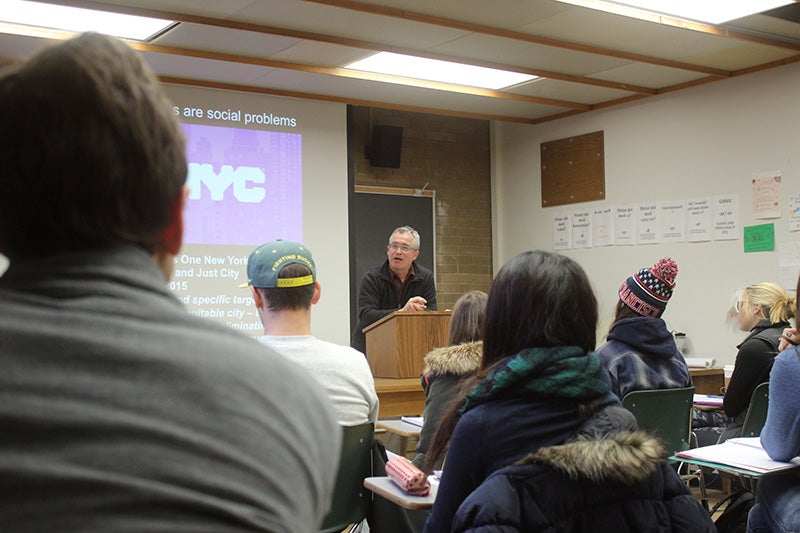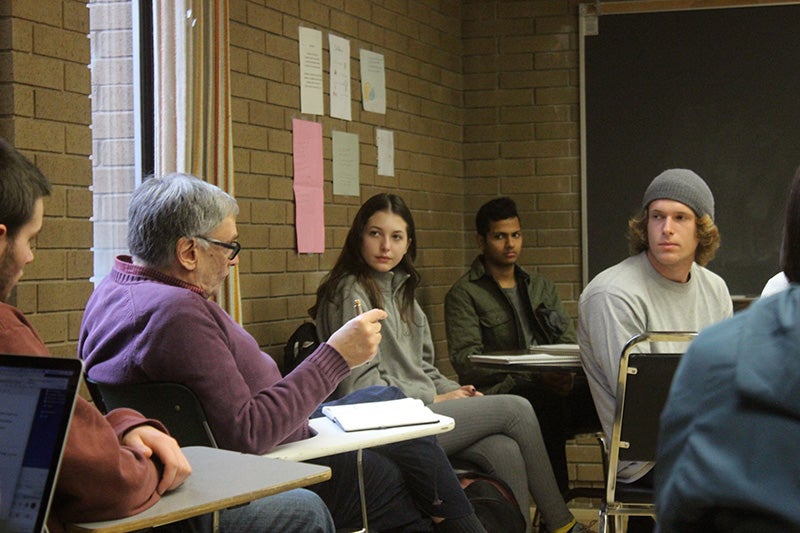The standard model for urban design and city growth, some A&AA professors argue, neglects a sizeable number of its residents.
Gentrification and makeovers within distressed neighborhoods can push out low-income communities by increasing property values; disabled, elderly, and handicapped populations are marginalized; and others, including children, are consistently sidelined, all in the name of progress that affects developing cities.
A city’s urban design can unintentionally lower living standards for certain residents and communities. Poorer populations often live in the more polluted parts of cities and in regions more prone to flooding, while affluent residents are likely to live upwind from smog and at elevations above flood line.
“The manner in which cities have grown during the Industrial Era and now in a time of globalization raises critical issues in terms of the relationship between social stratification and urban form,” says A&AA Interim Dean Brook Muller.

Above: A&AA Interim Dean Brook Muller speaks during the Inclusive Urbanism class the first week of winter term. "There's no social corollary to LEED," says Muller, referring to the comprehensive eco-friendly design certification program, Leadership in Energy and Environmental Design. Photos by Emerson Malone.
When three A&AA professors recognized that they all considered this issue from different, respective approaches, they collaborated in founding a new interdisciplinary course: AAA 321, “Inclusive Urbanism.”
The course aims to question the conventional city planning model and analyze how a new approach could be wide-ranging and hospitable to all residents, regardless of demographic.
Howard Davis, Department of Architecture professor; Gerardo Sandoval, Department of Planning, Public Policy, and Management assistant professor; and Muller are spearheading the course.
“The city works best when everyone—rich and poor, black and white, native and immigrant, etcetera—has a fair chance of taking advantage of its opportunities,” says Davis. “The physical form of the city plays a role in setting the stage for this.”
The four-credit course, initiated winter term 2016, is investigating the relationship between a city’s physical form and its effect on urban life for residents. The course will analyze this issue from a variety of angles (a building, neighborhood, district, and city) and from multiple planning perspectives (architecture, planning, public policy, landscape architecture, law, social science, and environmental studies) to recognize the best ways to promote social equity.
Often-overlooked populations include impoverished communities, ethnic minorities, children, and other vulnerable populations with little say in the overall scheme of city design and planning. The course will focus on how a city’s spatial patterns, power structures, and territoriality can exacerbate discrimination and impact urban dwellers’ economic and social potential.
The course’s syllabus states that “urban exclusion”—the indirect ostracism of certain populations—is a result of prejudice, intolerance, and discrimination that has had lasting effects on the way cities form, and where and how its residents reside.
Open to all UO majors, “Inclusive Urbanism” offers students from multiple disciplines the chance to learn together, gain exposure to alternative approaches to city planning, and develop newfound perspectives on urban design.
The class is intended to be a component of a new “Integrative Design and Creative Studies” undergraduate major, currently under development.
“We’re trying to capitalize on the strengths of the school and provide students who might not otherwise find an enabling path to enter our school,” says Muller. The new major will include “a core curriculum intended to expose students to the breadth of methodologies within the school,” he adds.
Davis’s expertise is in city development as it relates to citizens being empowered to actively participate in civic design. Muller’s expertise resides in ecological architecture and urban environmental justice, while Sandoval focuses intensively on minority communities.
“All of these things are related, and given the School of Architecture and Allied Arts’ focus on issues of social justice, the course seemed like a natural thing to develop,” says Davis.

Above: "I wouldn't be a teacher if I weren't optimistic about the future," says architecture Professor Howard Davis (left) in the first week of the class.
A city ought to be developed from its “grassroots” rather than “top-down,” Davis notes. This parallels Sandoval’s emphasis on empowerment of communities of color and immigrants, whose populations tend to be disadvantaged in terms of decision-making. Muller’s expertise on environmental justice will tie these themes together.
Davis serves on the board of directors for the Collaborative for Inclusive Urbanism, an initiative comprised of architects and city planners. CIU has informed the course’s curriculum, including lending its name. Davis hopes students will offer ideas that will shape CIU’s ethos.
The course will introduce students to the fact that a city’s design invariably impacts its people and social groups, and that a one-size-fits-all approach can’t work, given the range of people affected.
Adds Muller, “One of our strengths in the school is dealing with social equity and environmental sustainability. That topic gets addressed in many different ways in many different disciplines.”
Sustainable architecture and green building technology is expensive and often unattainable for marginalized populations, Muller says, while sustainable design and energy-efficient buildings often support the affluent and neglect everyone else.
“In some ways—although certainly not in all instances —an architecture characterized as 'green' can end up perpetuating the very inequities that it ostensibly [addresses],” says Muller. “Could we be thinking about relatively robust, straightforward and inexpensive building systems and living landscape systems that benefit all people, not only the affluent?”
The course will feature guest and instructor lectures, as well as panel and class discussions. Among the guest speakers are Stephen Dueppen, UO assistant professor of anthropology, who will talk about the formative cities of Neolithic societies and how degrees of egalitarianism are reflected in the architecture and patterns of a city; and Anita M. Weiss, head of the Department of International Studies, who will speak about urban design patterns in cities such as Lahore, Pakistan, where architecture tends to encourage gender segregation that isolates women from the public and from open spaces.
Sandoval helped conceptualize the course, secure funding, identify certain guest lecturers, and is providing lectures.
“The idea for this course emerged from A&AA’s Equity and Inclusion Committee. So I am very excited to continue that effort by collaborating with Howard Davis and Brook Muller,” he says.
“Inclusive Urbanism” satisfies a group requirement in social science and satisfies the multicultural requirement (Category B: Identity, Pluralism, and Tolerance).
